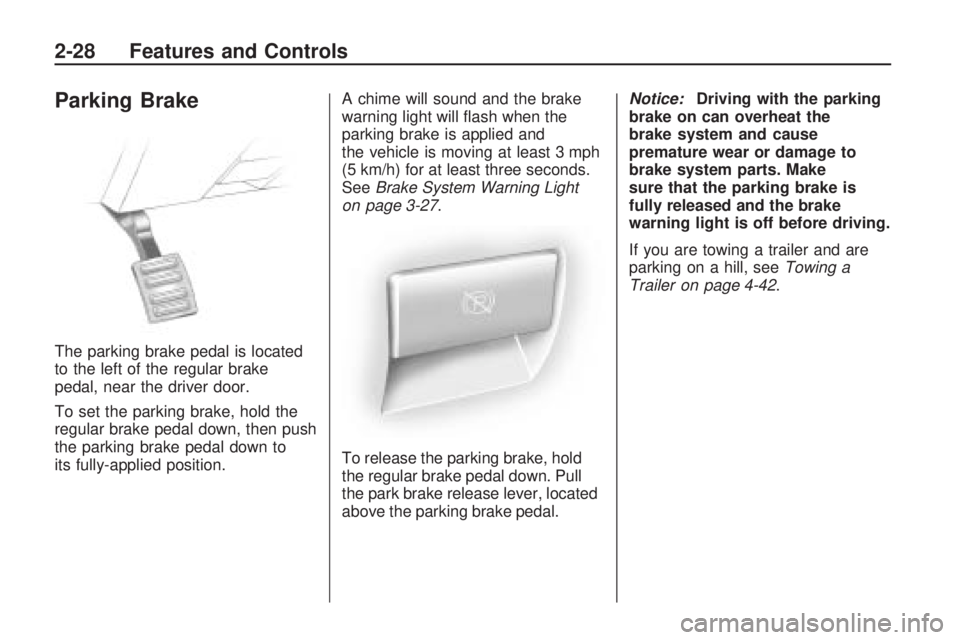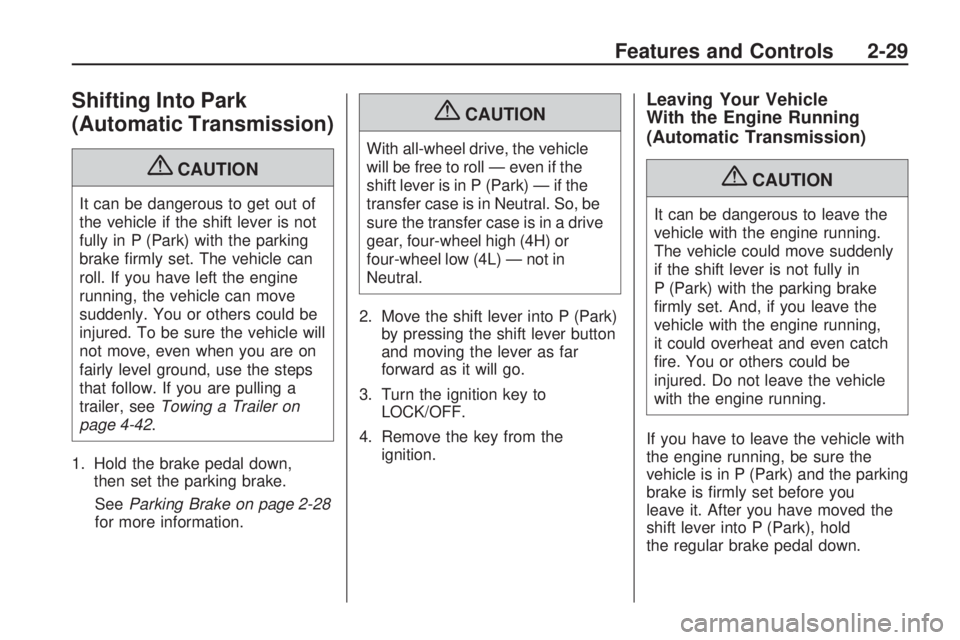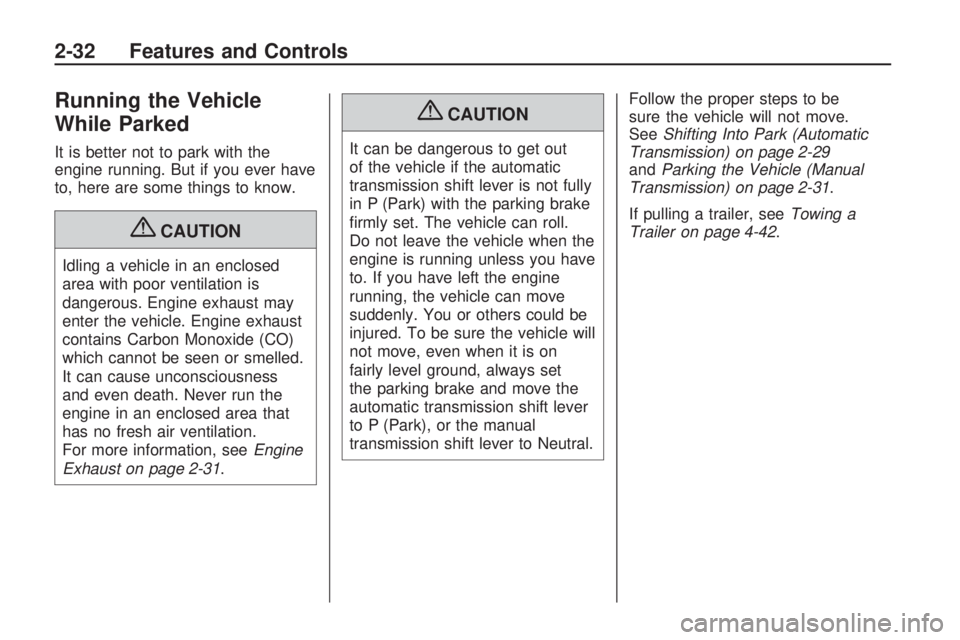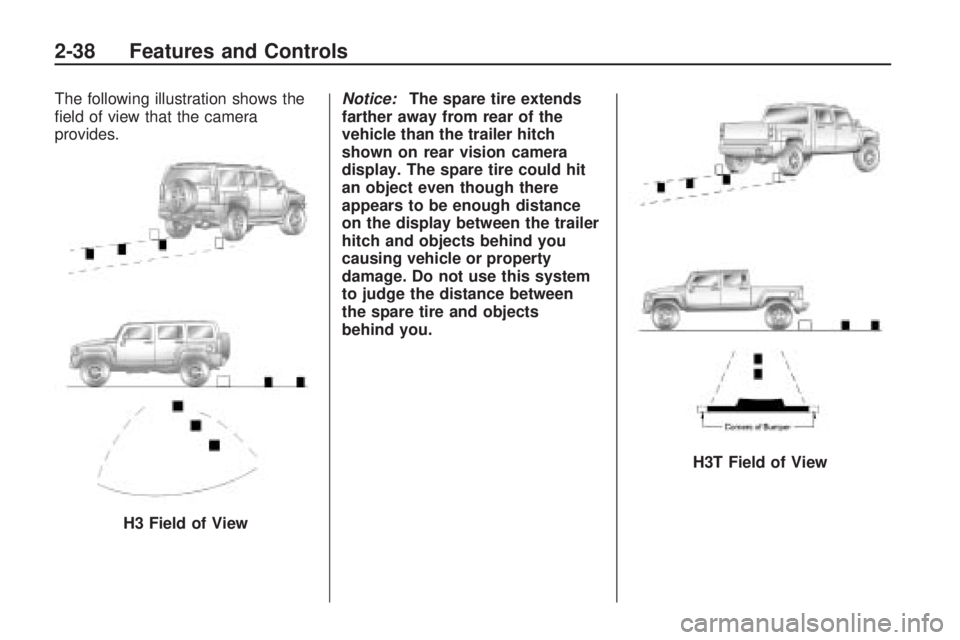trailer HUMMER H3 2009 Owners Manual
[x] Cancel search | Manufacturer: HUMMER, Model Year: 2009, Model line: H3, Model: HUMMER H3 2009Pages: 382, PDF Size: 1.99 MB
Page 81 of 382

5. After the engine has started, turn
the key to LOCK/OFF, and
remove the key. Insert the key to
be programmed and turn it to
ON/RUN within ten seconds of
removing the previous key.
The security light turns off once
the key has been programmed.
6. Repeat the Steps 1 through 5
if additional keys are to be
programmed.
If the security light comes on and
stays on while driving, the engine
will restart if you turn it off. However,
the theft-deterrent system is not
working properly and must be
serviced by your dealer/retailer.
The vehicle is not protected by the
theft-deterrent system at this time.
In an emergency, contact Roadside
Assistance. SeeRoadside Service
on page 7-6.
Do not leave the key or device that
disarms or deactivates the theft
deterrent system in the vehicle.Starting and
Operating Your
Vehicle
New Vehicle Break-In
Notice:The vehicle does
not need an elaborate break-in.
But it will perform better in
the long run if you follow these
guidelines:
Keep your speed at 55 mph
(88 km/h) or less for the
�rst 500 miles (805 km).
Do not drive at any one
constant speed, fast or slow,
for the �rst 500 miles (805 km).
Do not make full-throttle
starts. Avoid downshifting to
brake or slow the vehicle.
Avoid making hard stops for
the �rst 200 miles (322 km)
or so. During this time the
new brake linings are not yet
broken in. Hard stops with new
linings can mean premature
wear and earlier replacement.
Follow this breaking-in
guideline every time you get
new brake linings.
Do not tow a trailer during
break-in. SeeTowing a
Trailer on page 4-42for the
trailer towing capabilities of the
vehicle and more information.
Following break-in, engine
speed and load can be gradually
increased.
Features and Controls 2-15
Page 86 of 382

It features an electronic shift
position indicator within the
instrument cluster.
There are several different positions
for the shift lever.
P (Park):This position locks the
rear wheels. It is the best position
to use when you start the engine
because the vehicle cannot
move easily.
{CAUTION
It is dangerous to get out of the
vehicle if the shift lever is not fully
in P (Park) with the parking brake
�rmly set. The vehicle can roll.
Do not leave the vehicle when the
engine is running unless you have
to. If you have left the engine
running, the vehicle can move
suddenly. You or others could be
injured. To be sure the vehicle will
not move, even when you are on
fairly level ground, always set the
parking brake and move the shift
lever to P (Park). SeeShifting Into
Park (Automatic Transmission) on
page 2-29. If you are pulling a
trailer, seeTowing a Trailer on
page 4-42.
Make sure the shift lever is fully in
P (Park) before starting the engine.
The vehicle has an automatic
transmission shift lock controlsystem. You must fully apply the
regular brakes �rst and then press
the shift lever button before you
can shift from P (Park) when
the ignition key is in ON/RUN. If you
cannot shift out of P (Park), ease
pressure on the shift lever and push
the shift lever all the way into
P (Park) as you maintain brake
application. Then press the
shift lever button and move the shift
lever into another gear. See
Shifting Out of Park (Automatic
Transmission) on page 2-30
R (Reverse):Use this gear to
back up.
Notice:Shifting to R (Reverse)
while the vehicle is moving
forward could damage the
transmission. The repairs would
not be covered by the vehicle
warranty. Shift to R (Reverse)
only after the vehicle is stopped.
2-20 Features and Controls
Page 87 of 382

To rock the vehicle back and forth to
get out of snow, ice, or sand without
damaging the transmission, see
If Your Vehicle is Stuck in Sand,
Mud, Ice, or Snow on page 4-33
N (Neutral):In this position, the
engine does not connect with
the wheels. To restart the engine
when the vehicle is already moving,
use N (Neutral) only.
{CAUTION
Shifting into a drive gear while the
engine is running at high speed is
dangerous. Unless your foot is
�rmly on the brake pedal, the
vehicle could move very rapidly.
You could lose control and hit
people or objects. Do not shift into
a drive gear while the engine is
running at high speed.Notice:Shifting out of P (Park)
or N (Neutral) with the engine
running at high speed may
damage the transmission. The
repairs would not be covered by
the vehicle warranty. Be sure
the engine is not running at high
speed when shifting the vehicle.
D (Drive):This position is for
normal driving. It provides the best
fuel economy. If you need more
power for passing, and you are:
Going less than about 35 mph
(55 km/h), push the accelerator
pedal about halfway down.
Going about 35 mph (55 km/h) or
more, push the accelerator all
the way down.
Downshifting the transmission in
slippery road conditions could result
in skidding, see “Skidding” under
Loss of Control on page 4-12.D (Drive) can be used when towing
a trailer. You may want to shift
the transmission to 3 (Third) or,
if necessary, a lower gear if
the transmission shifts too often
under heavy loads or in hilly
conditions.
3 (Third):This position is also used
for normal driving. However it
reduces vehicle speed more than
D (Drive) without using the brakes.
You might choose 3 (Third) instead
of D (Drive) when driving on hilly or
winding roads, or when towing a
trailer, so there is less shifting
between gears, or when going
down a steep hill.
2 (Second):This position reduces
vehicle speed even more than
3 (Third) without using the brakes.
You can use 2 (Second) on hills.
It can help control vehicle speed as
you go down steep mountain roads,
but then you would also want to use
the brakes off and on.
Features and Controls 2-21
Page 94 of 382

Parking Brake
The parking brake pedal is located
to the left of the regular brake
pedal, near the driver door.
To set the parking brake, hold the
regular brake pedal down, then push
the parking brake pedal down to
its fully-applied position.A chime will sound and the brake
warning light will �ash when the
parking brake is applied and
the vehicle is moving at least 3 mph
(5 km/h) for at least three seconds.
SeeBrake System Warning Light
on page 3-27.
To release the parking brake, hold
the regular brake pedal down. Pull
the park brake release lever, located
above the parking brake pedal.Notice:Driving with the parking
brake on can overheat the
brake system and cause
premature wear or damage to
brake system parts. Make
sure that the parking brake is
fully released and the brake
warning light is off before driving.
If you are towing a trailer and are
parking on a hill, seeTowing a
Trailer on page 4-42.
2-28 Features and Controls
Page 95 of 382

Shifting Into Park
(Automatic Transmission)
{CAUTION
It can be dangerous to get out of
the vehicle if the shift lever is not
fully in P (Park) with the parking
brake �rmly set. The vehicle can
roll. If you have left the engine
running, the vehicle can move
suddenly. You or others could be
injured. To be sure the vehicle will
not move, even when you are on
fairly level ground, use the steps
that follow. If you are pulling a
trailer, seeTowing a Trailer on
page 4-42.
1. Hold the brake pedal down,
then set the parking brake.
SeeParking Brake on page 2-28
for more information.
{CAUTION
With all-wheel drive, the vehicle
will be free to roll — even if the
shift lever is in P (Park) — if the
transfer case is in Neutral. So, be
sure the transfer case is in a drive
gear, four-wheel high (4H) or
four-wheel low (4L) — not in
Neutral.
2. Move the shift lever into P (Park)
by pressing the shift lever button
and moving the lever as far
forward as it will go.
3. Turn the ignition key to
LOCK/OFF.
4. Remove the key from the
ignition.
Leaving Your Vehicle
With the Engine Running
(Automatic Transmission)
{CAUTION
It can be dangerous to leave the
vehicle with the engine running.
The vehicle could move suddenly
if the shift lever is not fully in
P (Park) with the parking brake
�rmly set. And, if you leave the
vehicle with the engine running,
it could overheat and even catch
�re. You or others could be
injured. Do not leave the vehicle
with the engine running.
If you have to leave the vehicle with
the engine running, be sure the
vehicle is in P (Park) and the parking
brake is �rmly set before you
leave it. After you have moved the
shift lever into P (Park), hold
the regular brake pedal down.
Features and Controls 2-29
Page 97 of 382

Parking the Vehicle
(Manual Transmission)
If the vehicle has a manual
transmission, before you get out of
the vehicle, move the shift lever
into R (Reverse), and �rmly apply
the parking brake. Once the
shift lever has been placed into
R (Reverse) with the clutch pedal
pressed in, turn the ignition key
to LOCK/OFF, remove the key and
release the clutch.
If you are parking on a hill, or if the
vehicle is pulling a trailer, see
Towing a Trailer on page 4-42.
Parking Over Things
That Burn
{CAUTION
Things that can burn could touch
hot exhaust parts under the
vehicle and ignite. Do not park
over papers, leaves, dry grass, or
other things that can burn.
Engine Exhaust
{CAUTION
Engine exhaust contains Carbon
Monoxide (CO) which cannot be
seen or smelled. Exposure to CO
can cause unconsciousness and
even death.
Exhaust may enter the vehicle if:
The vehicle idles in areas
with poor ventilation (parking
garages, tunnels, deep snow
that may block underbody
air�ow or tail pipes).
The exhaust smells or
sounds strange or different.
The exhaust system leaks
due to corrosion or damage.
(Continued)
CAUTION (Continued)
The vehicle’s exhaust system
has been modi�ed, damaged
or improperly repaired.
There are holes or openings
in the vehicle body from
damage or after-market
modi�cations that are not
completely sealed.
If unusual fumes are detected or if
it is suspected that exhaust is
coming into the vehicle:
Drive it only with the windows
completely down.
Have the vehicle repaired
immediately.
Never park the vehicle with the
engine running in an enclosed
area such as a garage or a
building that has no fresh air
ventilation.
Features and Controls 2-31
Page 98 of 382

Running the Vehicle
While Parked
It is better not to park with the
engine running. But if you ever have
to, here are some things to know.
{CAUTION
Idling a vehicle in an enclosed
area with poor ventilation is
dangerous. Engine exhaust may
enter the vehicle. Engine exhaust
contains Carbon Monoxide (CO)
which cannot be seen or smelled.
It can cause unconsciousness
and even death. Never run the
engine in an enclosed area that
has no fresh air ventilation.
For more information, seeEngine
Exhaust on page 2-31.
{CAUTION
It can be dangerous to get out
of the vehicle if the automatic
transmission shift lever is not fully
in P (Park) with the parking brake
�rmly set. The vehicle can roll.
Do not leave the vehicle when the
engine is running unless you have
to. If you have left the engine
running, the vehicle can move
suddenly. You or others could be
injured. To be sure the vehicle will
not move, even when it is on
fairly level ground, always set
the parking brake and move the
automatic transmission shift lever
to P (Park), or the manual
transmission shift lever to Neutral.Follow the proper steps to be
sure the vehicle will not move.
SeeShifting Into Park (Automatic
Transmission) on page 2-29
andParking the Vehicle (Manual
Transmission) on page 2-31.
If pulling a trailer, seeTowing a
Trailer on page 4-42.
2-32 Features and Controls
Page 104 of 382

The following illustration shows the
�eld of view that the camera
provides.Notice:The spare tire extends
farther away from rear of the
vehicle than the trailer hitch
shown on rear vision camera
display. The spare tire could hit
an object even though there
appears to be enough distance
on the display between the trailer
hitch and objects behind you
causing vehicle or property
damage. Do not use this system
to judge the distance between
the spare tire and objects
behind you.
H3 Field of View
H3T Field of View
2-38 Features and Controls
Page 135 of 382

Electric Power
Management
The vehicle has Electric Power
Management (EPM) that estimates
the battery’s temperature and
state of charge. It then adjusts the
voltage for best performance
and extended life of the battery.
When the battery’s state of charge
is low, the voltage is raised
slightly to quickly bring the charge
back up. When the state of charge is
high, the voltage is lowered
slightly to prevent overcharging. If
the vehicle has a voltmeter gage or
a voltage display on the Driver
Information Center (DIC), you may
see the voltage move up or
down. This is normal. If there is a
problem, an alert will be displayed.
The battery can be discharged
at idle if the electrical loads are very
high. This is true for all vehicles.
This is because the generator
(alternator) may not be spinning fastenough at idle to produce all the
power that is needed for very high
electrical loads.
A high electrical load occurs when
several of the following are on, such
as: headlamps, high beams, fog
lamps, rear window defogger,
climate control fan at high speed,
heated seats, engine cooling fans,
trailer loads, and loads plugged into
accessory power outlets.
EPM works to prevent excessive
discharge of the battery. It does this
by balancing the generator’s
output and the vehicle’s electrical
needs. It can increase engine
idle speed to generate more power,
whenever needed. It can temporarily
reduce the power demands of
some accessories.
Normally, these actions occur in
steps or levels, without being
noticeable. In rare cases at the
highest levels of corrective action,this action may be noticeable to the
driver. If so, a Driver Information
Center (DIC) message might be
displayed, such as BATTERY
SAVER ACTIVE, BATTERY
VOLTAGE LOW, or LOW BATTERY.
If this message is displayed, it is
recommended that the driver reduce
the electrical loads as much as
possible. SeeDIC Warnings and
Messages on page 3-37.
Battery Run-Down
Protection
This feature shuts off the dome
lamp if it is left on for more
than 20 minutes when the ignition is
in LOCK/OFF. This helps to
prevent the battery from being
drained.
Instrument Panel 3-17
Page 149 of 382

the vehicle’s fuel economy might
not be as good, and the engine
might not run as smoothly.
This could lead to costly repairs
that might not be covered by
the vehicle warranty.
Notice:Modi�cations made to
the engine, transmission,
exhaust, intake, or fuel system of
the vehicle or the replacement
of the original tires with other
than those of the same Tire
Performance Criteria (TPC) can
affect the vehicle’s emission
controls and can cause this light
to come on. Modi�cations to
these systems could lead
to costly repairs not covered by
the vehicle warranty. This
could also result in a failure to
pass a required Emission
Inspection/Maintenance test. See
Accessories and Modifications
on page 5-3.This light comes on during a
malfunction in one of two ways:
Light Flashing:A mis�re condition
has been detected. A mis�re
increases vehicle emissions and
could damage the emission control
system on the vehicle. Diagnosis
and service might be required.
The following can prevent more
serious damage to the vehicle:
Reduce vehicle speed.
Avoid hard accelerations.
Avoid steep uphill grades.
If towing a trailer, reduce the
amount of cargo being hauled
as soon as it is possible.
If the light continues to �ash, when
it is safe to do so, stop the
vehicle. Find a safe place to park
the vehicle. Turn the key off, wait at
least 10 seconds, and restart the
engine. If the light is still �ashing,
follow the previous steps and
see your dealer/retailer for service
as soon as possible.Light On Steady:An emission
control system malfunction has been
detected on the vehicle. Diagnosis
and service might be required.
An emission system malfunction
might be corrected by:
Make sure the fuel cap is fully
installed. SeeFilling the Tank
on page 5-7. The diagnostic
system can determine if the fuel
cap has been left off or
improperly installed. A loose or
missing fuel cap allows fuel
to evaporate into the atmosphere.
A few driving trips with the cap
properly installed should turn
the light off.
If the vehicle has been driven
through a deep puddle of
water, the vehicle’s electrical
system might be wet. The
condition is usually corrected
when the electrical system dries
out. A few driving trips should
turn the light off.
Instrument Panel 3-31